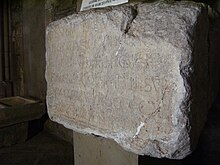Wilfried II (Barcelona)
Wilfried II. Borrell I ( Catalan Guifré Borrell , Spanish Wifredo Borrell ; † April 26, 911 ) was a Count of Barcelona , Girona and Osona from the House of Barcelona . He was one of the sons of the dynasty founder Wilfried the Hairy and Guinedilda.
Life
Since his older brother Radulf had embarked on a clerical career, Wilfried Borrell was the main heir to his father and inherited this in the most important centers of power in Barcelona , Girona and Osona . Apparently he had to share the rule with his brother Sunyer . The other two brothers, Miró and Sunifred , were given peripheral territories. As the senior of the family, Wilfried, who was also called Borrell, held the title of count (comes) as well as that of margrave (marchio) , who identified him as a liege in the old Spanish march and underlined his priority over the brothers.
His wife was called Gersende, presumably a daughter of Count Odo von Toulouse and Gersende von Albi, whom he had married from 898. The couple had a daughter, Richilda (Riquilda, † 962), who married Vice Count Odo I of Narbonne in 933. It is possible that Radulf, son of Count Wilfried, mentioned in 911 and 913, was his son, if he was not identical with his brother.
Wilfried Borrell moved to the west Franconian royal court in Tours-sur-Marne in 899 and was there by King Charles III. confirmed in writing to the simple-minded in the possession of the pagi of Osona and Manresa . Probably he had previously sworn the king's oath. He was the last Count of Barcelona whose personal presence at the royal court is documented. A few years later, his nephew Wilfried II von Besalú was also the last Catalan count ever to visit the royal court in 952 , which illustrates the increasing independence of the historical region of Catalonia from the Frankish Empire from the early 10th century.
Wilfried Borrell died in 911 and was buried in the monastery church of Sant Pau del Camp in Barcelona, which he founded . According to the account of the facts of the Counts of Barcelona, which began in the late 12th century and is pervaded by legendary tales, he is said to have been poisoned by his own child. His brother Sunyer assumed sole rule.
literature
- Ramon d'Abadal i de Vinyals: Un gran comte de Barcelona preterit: Guifre-Borrell (897-911) , In: Cuadernos de Arqueología e Historia de la Ciudad de Barcelona , Vol. 5 (1964), pp. 83-180.
- Miquel Coll i Alentorn: Història / 2 (Textos i estudis de cultura catalana). Pp. 201-203, L'Abadia de Montserrat, 1992.
Remarks
- ↑ "Wilfredo comite hac marchio que vocant Borrello ..." Cartulario de Sant Cugat del Vallés , Vol. 1, ed. by José Rius Serra (1945), No. 3, p. 6.
- ↑ Catalunya Carolíngia II: els diplomes carolíngis a Catalunya. Secona part , ed. by Ramon d'Abadal i de Vinyals in, Memòries de la Secció Històrico-Aqueològica (2007), No. 34, pp. 375-377.
- ↑ Coll i Alentorn, p. 191.
- ↑ Ex Gestis Comitum Barcinonensium , §2, in: Recueil des Historiens des Gaules et de la France , Vol. 9 (1874), p. 69.
Web link
| predecessor | Office | successor |
|---|---|---|
| Wilfried I. the hairy |
Count of Barcelona Count of Girona and Osona 897–911 |
Sunyer |
| personal data | |
|---|---|
| SURNAME | Wilfried II. |
| ALTERNATIVE NAMES | Borrell I. |
| BRIEF DESCRIPTION | Count of Barcelona, Girona and Ausona |
| DATE OF BIRTH | 9th century |
| DATE OF DEATH | April 26th 911 |

